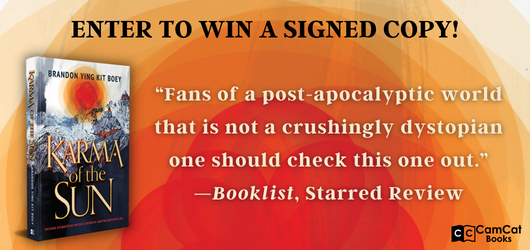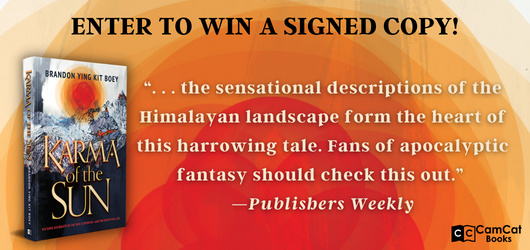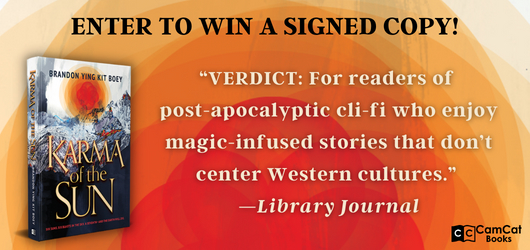A Post-Apocalyptic Hero's Journey from an Eastern Perspective
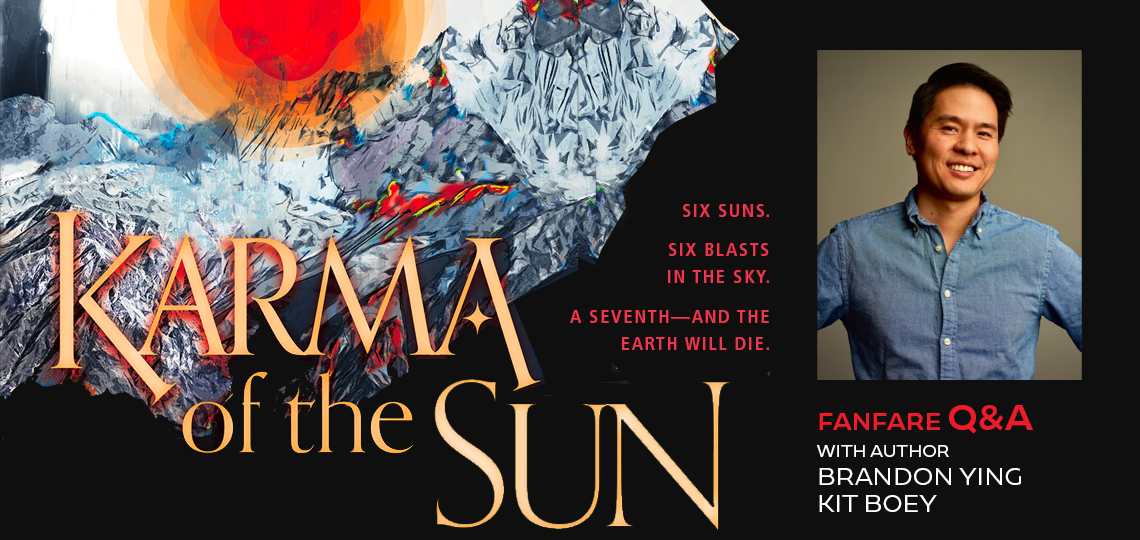
Reviewer Jeana Jorgensen Interviews Brandon Ying Kit Boey, Author of Karma of the Sun
Death is in the cards for all of us, a certainty—and that reality plays a big role in who we are and how we live our lives.
But death by apocalypse holds a special terror. The notion that all of humanity might end in an instant is, well, unspeakable. Which helps explain the morbid, can’t-look-away popularity of a good apocalypse novel.
Brandon Ying Kit Boey’s Karma of the Sun explores an even darker nuclear holocaust scenario by setting his novel in the Himalayas where Buddhists believers in karma and reincarnation understand that the notion of an afterlife also perishes when Earth is destroyed. Talk about high stakes.
Jeana Jorgensen reviewed Karma of the Sun in Foreword’s January/February 2023 issue and when we reached out, she jumped at the chance to ask Brandon about some of the key features of the book.
The book tells of an apocalypse part-finished; it seems that much of life on earth has been obliterated, and those who remain are surviving in the region where the Himalayas once stood. Why did you choose to write about an interrupted apocalypse?
I had become tapped into a despondency, which I was not alone in feeling, about the fate of the world. It seemed very bleak to me that in the stories that we tell of humanity and the world, regardless of the culture, there is always an apocalyptic end. What is a young person supposed to do when faced with such a dire prediction of the future? Throw in the belief of karma—this meritorious idea that one’s individual acts of good can determine your future—and it seems like we are at odds, or at least that we’re saying that the collective karma of others can overpower whatever individual force there is. This didn’t feel right to me and, in fact, deep down I didn’t believe it, so I wanted to test that.
So I took the extreme setting in Karma of the Sun where the apocalypse has all but happened, where the first six of seven apocalyptic suns (nuclear blasts) have occurred, which I drew from real Buddhist texts, to see if this young person—Karma—could get out of this. Here is a person, having grown up in the shadow of this curse of his progenitors, in circumstances where he feels personal blame for his village’s additional misfortunes, who has every reason to believe that the end is nigh. There is no purpose, no need for desire, no way out.
But then something strange happens. On the eve of the apocalypse, he decides he wants to see his father one last time. So he sets off, apocalypse be damned, to find him. And it is this simple and seemingly insignificant act—this assertion of will and exercise of hope—that may well change the course of the future for the entire world.
Yaks appear in both the book’s beginning and ending. Is there any particular symbolism associated with the yak, or any other reason you chose the animal to open and close the book?
In Tibet, yaks are beasts of burden, but also an indescribable resource—for meat, wool, milk and butter, and even dung for fuel. When they find the prized calfing killed and inexplicably mutilated in the beginning, it feels like another betrayal of nature, which used to provide for them. In fact, they view it as another sign of the curse, the coming of the seventh and final sun to destroy their home in Tibet, which is the last bastion of human civilization. It increasingly seems that they are alone. For people who believe in reincarnation, the idea that the earth and all life will be gone is an even greater threat than death because it means the end of any continuation of the afterlife. It causes even the nun to lose hope. In contrast, the appearance of the yak in the end is under very different circumstances.
How did you go about selecting quotes from the Lotus Sutra to utilize in the book?
I came across the quotes in my research of Buddhist texts. The Lotus Sutra is a book in the Tibetan Buddhist canon from the first century CE, which contains a lot of very beautiful stories and allegories about the path to enlightenment. I was struck by the parallels to the story of young Karma, who it can be said is on his own path to enlightenment. There is one quote from the Sutra which I came upon after the manuscript was already completed, and it describes the Stone’s prismatic properties in conveying the gift of a bodhisattva’s sight. The similarities were uncanny. But there were so many examples of things like that, where something that seemed speculative in the story was rooted in some text or tradition somewhere.
Technology seems muted in many ways: people fight with arrows as well as rifles, and there doesn’t seem to be any capability for long-distance communication. And yet this narrative is likely set in the future. What made you envision a future with less rather than more technology?
Some of that seemingly anachronistic technology is still currently very much in use in parts of Tibet. In some more remote areas, you’ll find old matchlock rifles alongside spears, and modes of housing that differ very little from a few hundred years ago. My feeling has always been that people from a high-technology civilization would be less resilient to the kind of world-changing catastrophe as the one in Karma of the Sun. It’s one reason I wanted to see a post-apocalyptic story that takes place outside of the major Western city setting so favored by these types of stories.
I understand the interest in those settings—the contrast of the city before and after is a powerful statement, and the sense of loss permeates those stories. But I thought it would be just as interesting to see the end in a setting where little has changed otherwise. I liked the timeless feel of the beginning and the end, trying to point out that we really are not that far removed from what we might think of as primitive conditions. In that kind of stark setting, the natural forces of the earth dominate in a dramatic way.
The connection between the earthly world and the spirit world is jeopardized in the book, and must be repaired. Is this a theme you see being explored in other apocalyptic literature?
In Karma of the Sun, a large part of the fear is that not only is the world coming to an end, but so is the earth itself. The ending of the planet represents a threat to an afterlife within the paradigm of reincarnation in the sense that there will soon be nowhere for the reincarnated to go, therefore the finality they are facing is a complete and existential one. It has brought out the worst of human nature, but also makes the resiliency of hope that much more remarkable. In this setting, where there are ghosts roaming the winds, mourning the impending end and loss of reincarnation from a state in limbo, the demarcation between the earthly and spirit worlds is especially thin. This is a real apocalypse, one that affects both the living—and the dead.
Hope is a major theme of the book, as is prophecy. Do you think the two are connected, and if so, how?
I think so. Certainly, a prophecy about a savior is one to give people hope. But prophecies can be vague things. In the world of Karma of the Sun, there is some ambiguity. Is it a specific person, already foreordained to this role, as in the case of the reincarnated lama? Or is it the conquest of the Mountain that confers that status and power? It also begs the question of the role of prophecy when doom is involved—is it to warn people so they can change course, or to simply give a preview before the inevitable? If it is unavoidable, then perhaps that prophecy may actually destroy hope. For me, the interesting question is the role of choice in interpreting the prophecy. Why does a person take a fear-based, pessimistic view, as in the case of Karma’s uncle, versus a different one?
There are many factions fighting to find the Lama child or to access the Seeing Stone: the Khan’s army, the Minister’s patrollers, the monks, the bandits, and so on. Do you see reflections of real-world political struggles in how all these groups vie for power and influence?
We look at these groups in the book and their state of warfare and wonder what they have to fight over when there’s hardly anything left. But we can ask the same thing now: with so much abundance and technology, why do we persist in the tribalistic, provincial conflicts that distract us instead of using those resources to solve the problems of the world?
The apocalyptic state is also an obvious comparison. The setting of the novel is of course much more extreme, where it’s the end of the end. It’s a tragedy that even on the eve of the apocalypse, it appears that the powers that be have not learned from the costly lessons of the previous generations. But that would make our time the beginning of the end. With a global pandemic, civil unrest, and threat of nuclear war higher than it has been for many years, indeed our world is closer to an apocalyptic state than it has been in many years. What are we doing to avert the crisis today?
Many characters in the book are friends, family members, or allies with one another, and they experience a variety of revelations and betrayals. How much would you say your book is about personal catastrophes vs. global catastrophes, or are they perhaps all related?
There’s a part in the book when Karma has an epiphany that “apocalypses, great and small, come for them all.” Deep down, we know that the “end” is coming for us all in terms of our own mortality, never mind the global catastrophes. We know loss and disappointment are inevitable. I think this is why post-apocalyptic books resonate the way that they do. We all will face our own apocalypse, and we know it. What we need is to remember to live like it: to be reminded that every moment matters. We sense that only then can we be liberated from the illusions plaguing us through life.
Aside from Buddhist themes and writing, what were some of the influences when you were conceptualizing and writing this book? Put another way, if your book were to be assigned in a class or a reading group, what kinds of supplemental readings or topics might you suggest for readers to better grasp some of the themes of your book?
I did quite a bit of cross-comparison of eschatological texts across different cultures. If one was so inclined to look, it may be surprising to see the consistencies in The Lotus Sutra or Pali Canon with Western or near Eastern texts, for example. From a historical and cultural context, I might also suggest readings from Magic and Mystery in Tibet by Alexandra David-Néel, and In Exile From the Land of Snows by John F. Avedon.
KARMA OF THE SUN
In the aftermath of six nuclear explosions, the world is in a state of devastation. In Brandon Ying Kit Boey’s science fiction novel Karma of the Sun, the threat of a seventh explosion looms—unless the reincarnated Lama child can be found in the shattered Himalayas. To find him, a man navigates the space between a prophecy, uncertainty, and his grief.
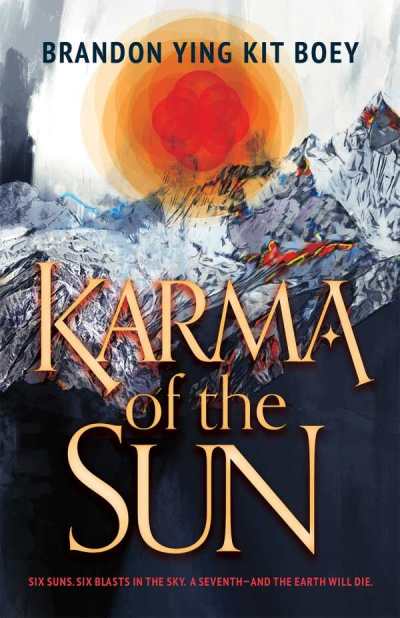
Karma—the son of a sherpa thought to be a liar and betrayer—is an outcast in his village. After bandits bring chaos to the village, Karma is persuaded by its rescuers to retrace his father’s footsteps and find the one remaining mountain in the Himalayas. The key to saving the world from nuclear annihilation is rumored to wait therein.
Hounded by the nighttime cries of ghosts, Karma sets out from his village, but he does not know who to trust: the military men that claimed to have rescued him, the outlaws helping fellow refugees, or the Buddhist monks who also seek the prophesied savior. Teaming up with Nima, Karma tries to figure out how to honor his father’s heritage while also doing what he can to save the world.
The inevitability of the seventh explosion, said to be the final blow that will destroy the earth, weighs on each person in the book. Violence and brutality blossom on most of its pages. Karma is captured, beaten, and almost killed, but he never gives up hope that he may yet contribute to the quest to save the planet. His explorations uncover secrets about his family and truths about the spiritual world that promise to change everyone’s lives forever.
Karma of the Sun is a gripping, prescient science fiction take on the apocalypse, blending Buddhism with an irresistible adventure.
Reviewed by Jeana Jorgensen January / February 2023
Jeana Jorgensen

